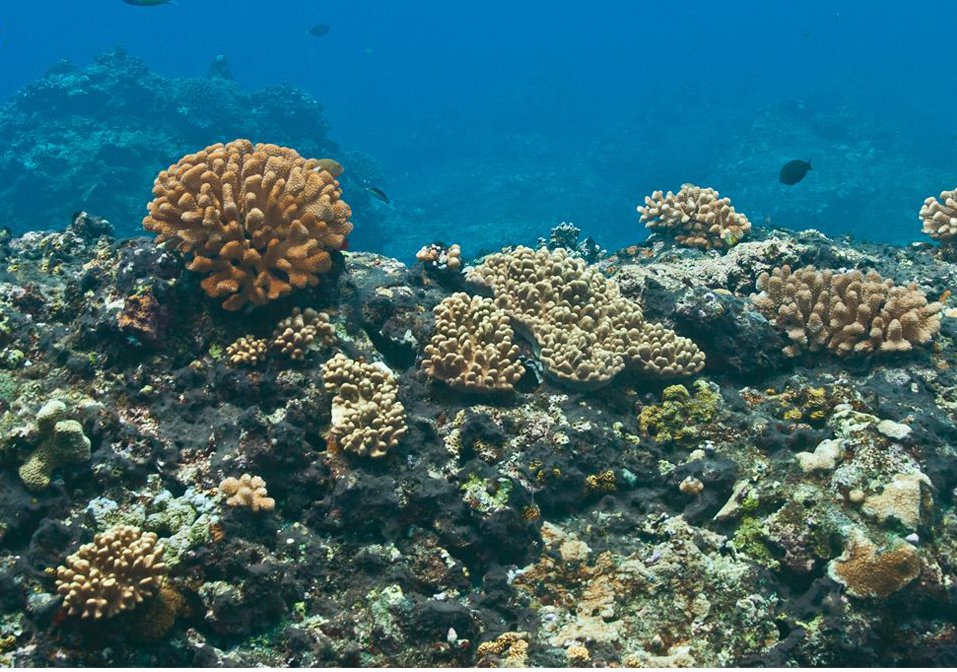What doesn’t kill a coral: A little ash is still a bad thing
Being buried in lava and piles of ash can quickly kill, whether above ground or underwater, but research published in PLOS ONE last week shows that even small amounts of volcanic ash can have a large impact on the health of coral reefs. Though not sufficient to smother the reefs, these lower amounts of ash can change the composition of ocean waters enough to cause coral damage.
The authors studied data recorded in 2009-2010 near Pagan Island in the tropical Pacific Northern Mariana Islands during a series of volcanic eruptions near pristine reef communities off the island. They found a sudden increase in the growth of blue-green algae coinciding with the eruptions. When volcanic activity ceased in 2011, the algal bloom also disappeared. Along with the algal bloom, the researchers found an increase in the population and activity of a species commonly known as the “killer sponge” (Terpios), named for its ability to invade and kill live coral.
Coral communities typically don’t have large algal populations, and algal bloom has been linked to reef degradation in previous studies in Pacific, Atlantic and Caribbean reefs. Herbivorous marine turtles are suggested to help keep these large algae in check on coral reefs by grazing on them, according to research published earlier this year in PLOS ONE.
Though the link between blue-green algae and the killer sponge isn’t entirely clear, the authors suggest the possibility of a symbiotic association between the two should be investigated further. Previous research shows that the volcanic ash sediments from Pagan were particularly rich in iron, and could have caused a spike in iron levels similar to the increases that occur near ship wrecks.
According to the paper, the iron-rich ash sediments from the eruption of Pagan likely triggered the algal bloom, which then promoted the growth of the coral-killing sponge. Like volcanoes, not all ash is identical, so the effects of underwater eruptions on coral reefs may not be the same everywhere. Though volcanic ash is known to be a hazard to humans and airplanes, its ecological impact is still being understood, especially in ocean communities like coral reefs.
Other recent PLOS ONE papers add to our understanding of the subtle impacts of a changing climate on these complex ecosystems: One study finds that ocean acidification can make one kind of reef fish incapable of identifying its predators, while others examine the effects of tropical storms and loss of coral species diversity in reefs.
Hot on the heels of (open access) research published in PNAS showing that nearly half the Great Barrier Reef has been destroyed by invasive starfish, coral bleaching and tropical cyclones, these studies add to our growing understanding of how complex reef communities can be impacted by natural disturbances and human activity.
Citations:
Schils T (2012) Episodic Eruptions of Volcanic Ash Trigger a Reversible Cascade of Nuisance Species Outbreaks in Pristine Coral Habitats. PLoS ONE 7(10): e46639. doi:10.1371/journal.pone.0046639
Goatley CHR, Hoey AS, Bellwood DR (2012) The Role of Turtles as Coral Reef Macroherbivores. PLoS ONE 7(6): e39979. doi:10.1371/journal.pone.0039979
Ferrari MCO, Manassa RP, Dixson DL, Munday PL, McCormick MI, et al. (2012) Effects of Ocean Acidification on Learning in Coral Reef Fishes. PLoS ONE 7(2): e31478. doi:10.1371/journal.pone.0031478
Madin JS, Hughes TP, Connolly SR (2012) Calcification, Storm Damage and Population Resilience of Tabular Corals under Climate Change. PLoS ONE 7(10): e46637. doi:10.1371/journal.pone.0046637
Images: Schils T (2012) Episodic Eruptions of Volcanic Ash Trigger a Reversible Cascade of Nuisance Species Outbreaks in Pristine Coral Habitats. PLoS ONE 7(10): e46639. doi:10.1371/journal.pone.0046639
top: Ash and gas plume emitted from Mount Pagan on July 14, 2010
below: Cyanobacteria (blue green algae) cover on hard-bottom reef habitats


